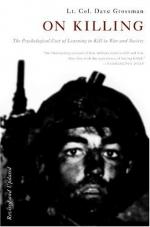
|
| Name: _________________________ | Period: ___________________ |
This quiz consists of 5 multiple choice and 5 short answer questions through Section 3, Killing and Physical Distance: From a Distance You Don't Look Anything Like a Friend: Chapter 1, Distance: A Qualitative Distinction in Death | Section 3, Killing and Physical Distance: From a Distance You Don't Look Anything Like a Friend: Chapter 2, Killing at Maximum and Long Range: Never a Need for Repentance or Regret.
Multiple Choice Questions
1. According to the DSM, when is Post-Traumatic Stress Disorder most severe?
(a) When it happens in wartime.
(b) When the victim was severely injured.
(c) When it happens in peacetime.
(d) When the trauma was caused by a person.
2. What percentage of casualties did cannon fire comprise in many Civil War battles?
(a) 4.
(b) 10.
(c) 23.
(d) 50.
3. Which of the following is not a sign of psychological trauma discussed in Chapter 1?
(a) Sporadic Violence.
(b) Fatigue States.
(c) Character Disorders.
(d) Obsessional and Compulsive States.
4. According to Grossman in Chapter 3, why do most soldiers refuse to discuss their aversion to killing?
(a) To scare would-be challengers.
(b) To save face with others.
(c) To impress civilians.
(d) To avoid court martial.
5. At the end of Chapter 6, Grossman says that what can provide a sudden injection of fortitude into a unit of men?
(a) Rest.
(b) Nothing.
(c) New leadership.
(d) Victory.
Short Answer Questions
1. At the end of Chapter 4, what reason does Grossman give for the increase in firing and killing in recent wars?
2. In Chapter 4, what World War II battle does Grossman cite as an example of hunger deciding combat?
3. In Chapter 7, Grossman says what has made killing easier for soldiers?
4. With what term does Grossman describe the reticence of the military to discuss non-firing in Chapter 3?
5. Why does fight-or-flight not come into play in a battle situation?
|
This section contains 275 words (approx. 1 page at 300 words per page) |

|




